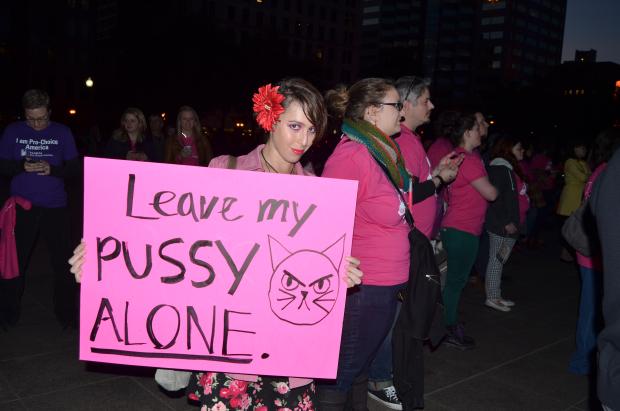The young woman hands me a hot pink tee shirt and a clipboard. “Please sign your support for funding Planned Parenthood.” She smiles broadly and continues, “I’m testifying tomorrow!” Chelsea Golferman was referring to the Ohio House of Representatives hearings which began Tuesday, October 20 for House Bill 294 to defund Planned Parenthood. In spite of the House panel limiting individual testimony to 90 seconds, women are signing up to testify that Wednesday.
“I first went to Planned Parenthood because I couldn’t afford to go to a private practice,” Golferman says. “I kept going because I got good health care. And I’ve never had an abortion.” You hear that a lot from women and families who use Planned Parenthood as a healthcare resource.
Demonstrators gathered on the steps of the Ohio Statehouse on that warm autumn evening to make clear the importance of Planned Parenthood in Ohio. It was a good turnout; several hundred people, young, old, women and men, mostly white that evening though Planned Parenthood is a mainstay for diverse and ethnic communities.
They hoped to dissuade legislators from passing any bills that would prevent Planned Parenthood from receiving state and federal funding.
Polls repeatedly confirm that at least 65 percent of Ohioans want the state to continue funding for Planned Parenthood.
Why wouldn’t the public want to see funding for a successful, economical and efficient health option? Consider these statistics from Ohio Planned Parenthood's 2014 Annual Report:
-
In 2014 almost 100,000 patients were seen. A full 59 percent were seeking family planning and birth control.
-
33 percent of patients’ visits were for HIV/STD screenings.
-
Almost 12,000 women were screened for cancer.
-
Only 2 percent of resources went for abortion services and 2 percent emergency contraception.
-
Over 10,000 people attended sex education classes.
Planned Parenthood is affiliated with more than 20 health centers across Ohio and for hundreds, even thousands of Ohio women, the services are a lifeline to decent, affordable healthcare. What escapes opponents of choice is the reality that the kinds of services Planned Parenthood offers actually reduce the number of abortions performed each year. Nevertheless, HB 294 passed the House as expected and is on the fast track.
“Jesus would not do what these Republicans are doing…” Nina Turner, a Democrat, former State Senator for the 25th District of Ohio, and former candidate for Ohio Secretary of State, was revving up the crowd.
It was an apt observation. The Ohio Republican-controlled legislature seemed determined to cut off state and federal funding to Planned Parenthood and reroute that money to pregnancy crisis centers and religious charities, among other places. The goal would be to redirect women into clinics that counsel strongly against abortion. However, what they are actually cutting are funds for HIV/AIDS programs, reducing infant mortality, treating breast and cervical cancer, and administering comprehensive sex education programs.
***
Make no mistake: Ohio is a battleground state in the national war against Planned Parenthood and women's reproductive healthcare rights. Indeed, Ohio has enacted some of the most restrictive legislation in the country, and other states are copying the model: death by a thousand cuts.
In Ohio, a woman must receive state-directed counseling including information to discourage abortion. There is a 24 hour wait period before the procedure, and since counseling must be provided in person prior to the wait period, it means two separate trips to the facility for the patient. Given the dearth of clinics remaining open in Ohio, this is a true hardship for many women and families.
Health plans offered in Ohio’s health exchange under the Affordable Care Act cover abortion only when the woman's life is endangered, or rape or incest. The same applies to insurance policies for public employees.
Chemical abortion i.e. use of medicines to induce abortion, is heavily restricted.
The parent of a minor must consent before an abortion is provided. Never mind the parent may actually be the sexual abuser in some cases.
An ultrasound before a procedure is now typically required to test for the fetal heartbeat. The woman is offered the option to view the image. Ultrasounds have been an effective tool for anti-choice advocates, creating confusion and anxiety for the patient.
Targeted Regulation of Abortion Providers (TRAP) has put many clinics out of business by requiring their buildings conform to the same standards as ambulatory surgical centers and requiring unnecessary transfer agreements between abortion providers and local hospitals. But, Catch 22: Ohio law forbids public hospitals from entering into those agreements though public hospitals are often the only nearby medical facility to deal with emergency situations. These are extreme requirements compared to many other states.
The flurry of legislation to date includes Pro-Choice House Bills to end wait periods, allow insurance coverage for abortion and public funding for all women’s health choices. Anti-Choice bills include Senate and House bills to impose a six week abortion ban, aka “Heartbeat Bill,” a 20-week ban on abortions (it is 24 weeks now), a ban on abortions of fetuses that test positive for Down's syndrome, a ban on fetal tissue donations and products derived from fetal tissue research, restrictions on chemical medical procedures to end a pregnancy and there are at least three bills to defund Planned Parenthood.
This week the Ohio Senate passed SB214 after only two committee hearings instead of the usual three, and sent it to the House. The bill would strip Planned Parenthood’s funding of services provided through programs like the ‘Healthy Moms Healthy Babies’ program, the Minority HIV/AIDS Initiative and the Violence Against Women Act, to name just a few.
The result of this concerted effort by Republican legislators and Ohio Right to Life activists will be a real hardship for the women and families who most need services. More than half of the state’s women’s health clinics have closed since Governor John Kasich took office. There are only eight left and 91 percent of Ohio women live in counties without reproductive choice services.
But defunding Planned Parenthood is not about abortion. Public funds cannot be used for abortion services anyway. It is about programs like infant mortality reduction. Planned Parenthood operates two of the state's 14 initiatives. These programs work with African-American women throughout their pregnancy, connecting mother to prenatal care and other resources, until the child is two years old. Planned Parenthood receives about $300,000 annually from the state-funded initiative. No funding means no (or severely reduced) programs.
So, would Jesus do what these Republicans are doing to women and children?
***
It feels like a time warp for a lot of women who grew up with the terrors and tragedies of life before the historic 1973 Roe v Wade decision. In 1992, the Courts upheld the basic right to abortion in Planned Parenthood v. Casey. However, there remains an army of people determined to return to those dark times of coat hangers and knitting needles, of lethal concoctions and desperate measures. Without assurances to reproductive health, women once again become second class citizens (second class even to the unborn), and slaves to chance, rape, incest, domestic abuse and poverty. Planned Parenthood is the organization that fights in court to uphold these essential rights for women, but that money could and should be better spent on family planning and healthcare rather than legal fees.
Looking around the crowd of glowing pink tee shirts, it doesn’t seem nearly big enough, given the stakes. Planned Parenthood is like National Public Radio. Both make communities and society better. Both depend on public and government funding, and both face fierce political, ideological opposition from the right. It is going to take more than a few hundred passionate proponents to save this mainstay of American healthcare.
One way to protect women’s rights and organizations like Planned Parenthood is to vote for candidates friendly to women and family issues. It is a conundrum that the politicians who cry loudest about the individual’s rights over government intrusion just can’t help intruding on women’s bodies. This is a moral imperative and every citizen is responsible.
The speakers at the rally represented some of Ohio’s most powerful women. Former Columbus City Council Representative and State Representative Charleta Tavares, Executive Director of Planned Parenthood of Greater Ohio Stephanie Kight and many more and all spoke eloquently. But it was Nina Turner whose final words echo long after her speech is over and everyone has left the State House grounds: “Sisters, if our hair is on fire, we ought to act like our hair is on fire. And sisters, our hair is on fire!”
Are you listening sisters? Our hair is on fire!





